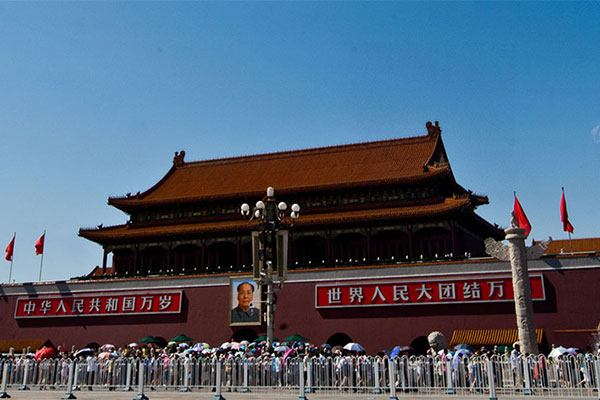
A walk along the central axis of the capital is a journey through hundreds of years of imperial splendor and unique city lifestyle where history and modernity vie for attention, writes Raymond Zhou.
The 2008 Beijing Olympics opened with a trail of giant footsteps walking from southern Beijing all the way to the National Stadium on the north side of the capital. The footsteps were formed by successive salvos of fireworks shot into the night sky, so the best vantage point would be that of a bird or plane flying overhead.
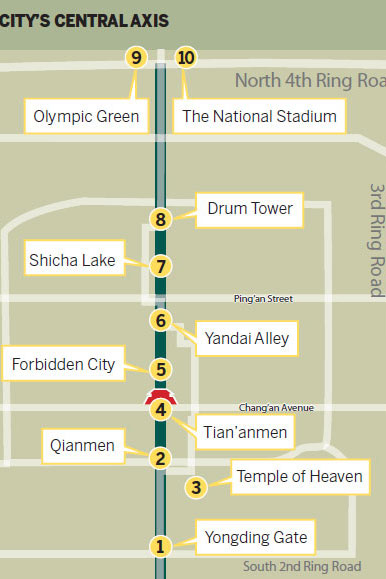
That was certainly an impressive way of making an entrance fit for an imaginary giant. But do not despair. A mere mortal can follow that path and walk up the central axis of the ancient city with imaginary pomp and pageantry. You may not leave awe-inspiring footprints, but you will garner much more intimate impressions of the city and its people than the giant would have.
Symmetry is of paramount importance to traditional Chinese urban layout and architecture, especially for the imperial city and palaces. The Chinese word for “China” is Middle Kingdom or Central Kingdom because earlier inhabitants believed they were at the center of the world. According to legend, Beijing’s central axis dates back to Kublai Khan (1215-1294), who shot arrows in four directions to determine the location of the capital of the Yuan Dynasty (often referred to as the Mongol Dynasty, AD 1271-1368). But that is definitely a legend that cannot be corroborated by science.
The invisible axis from that era was obviously inspired by capital cities of earlier dynasties. However, if you keep going north along the line, you will not end up at the North Pole. A few years ago, a Chinese scientist discovered the axis is two degrees to the west. After arduous research and investigation, he found that, 270 km to the north, lie the ruins of Shangdu, or Xanadu, the summer capital of the Khan.
Whether urban planners 750 years ago miscalculated, given their tools, or were ultraprecise in their calculation, we do not have enough evidence to determine. An accidental tourist should not be bothered by this, but rather use it to enhance his or her bragging rights.

Temple of Heaven
The central axis starts from Yongding Gate in the south and ends at the Clock Tower 7.8 km to the north. But the best starting place for a tourist is the Temple of Heaven, slightly to the east of the southern tip of the axis. Here you’ll be amazed to find that a square peg in a round hole, or vice versa, can be a wonderful principle in architecture. There are round buildings on square bases, and a square encirclement next to a round one. These are manifestations of the Chinese belief that “heaven is round and Earth square” and, as such, make the temple complex an ideal place for the emperor to pray. He was accountable only to heaven since he was supposed to be the son of heaven. In that sense, the annual praying session was somewhat equivalent to the State of the Union address a US president delivers to Congress.
Nowadays the real fun happens outside the temple, mostly in the eastern part of the park where Beijing residents of all ages congregate, mostly on weekends, to practice singing, sword dancing and chess, among myriad activities. Everyone is welcome to join them. Don’t be shy if you are in a mood to show off your talent, and you’ll quickly discover the Chinese love to communicate.
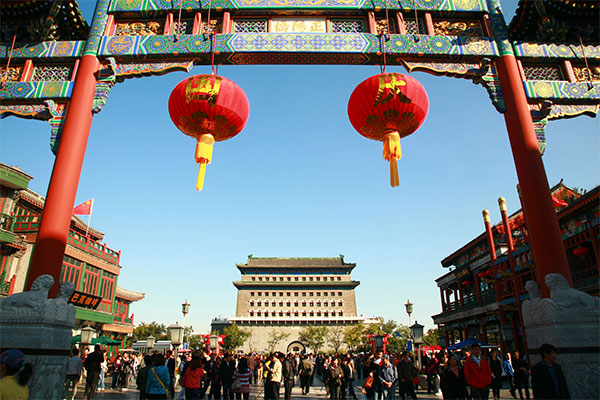
Qianmen
A short taxi drive away, you’ll find yourself in the Qianmen area. This is a commercial hub, which means there are tourist trinkets galore. and It is the birthplace of Peking duck and Chinese film.
Where Qianmen Street ends, Tian’anmen Square begins. Be prepared. You’ve got lots of walking to do because from this point onward no other form of transportation would be feasible, at least for most of the journey.
The square is solemn and grand, the place for the morning raising of the national flag and the evening lowering, as well as other ceremonies. To the west lies the Great Hall of the People and, farther west, the National Center for the Performing Arts. To the east is the National Museum, which is open to the public. Everything is within walking distance, but a block in Beijing is probably equal to 10 in New York. The square used to hold events with a million participants, and now it can still host a million a day — not at the same time though.
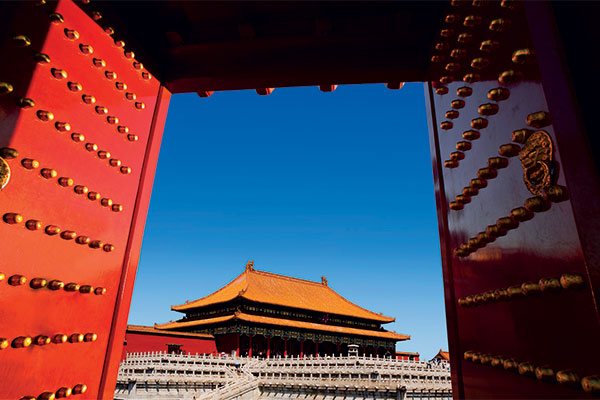
Forbidden City
Across the Avenue of Eternal Peace (Chang’an) is the entrance to the Forbidden City, now officially called the Palace Museum. Suffice to say, we cannot dwell on its details here as it merits its own article, or a separate day’s exploring. You can enter on any of its four sides, but the most dramatic entrance is on the south.
When you re-emerge from the palace through the north gate, you are advised to cross the street and visit Jingshan Park if the weather is good. On a clear day you get a panoramic view of the palace from the hill and a visceral feeling of the crumbling of power by visiting the tree where the last emperor of the Ming Dynasty hanged himself. A peasant rebel and his army had broken into the city and the emperor had nowhere else to turn. Maybe he just wished he had dug an underground maze for refuge. That was in 1644.

Shicha Lake and Drum Tower
A short taxi ride will take you to the Shicha Lake and Drum Tower area, which is the oldest retail center in the city. Rows of restaurants and cafes line the main street and its alleys. You can taste a variety of local snacks and foods from all over the country and the world. It is a magnet for international visitors who have a choice of culinary adventure or familiar cuisines. To work off the extra calories, you can skate on the lake in winter or row a boat in summer. You can also rent a pedicab and meander along the narrow lanes (hutong), visit some of the courtyard houses (siheyuan) and see how people in Beijing used to live in their humbler abodes of perfect symmetry. Some still live there, but most have moved into apartment buildings.
The central axis ends at the Clock Tower, where bells chime in the morning, and its neighboring Drum Tower sounds the evening drum rolls. But your walking tour need not end there as the axis has now been extended farther north to encompass the Olympic venues. You can either take a taxi or, if you’re in an adventurous mood, take subway Line 8 that corresponds to this portion of the central axis.
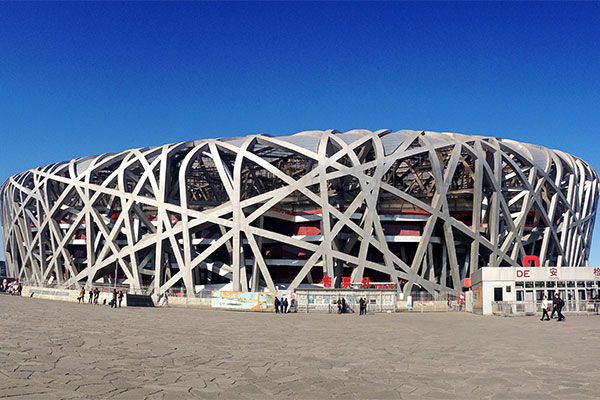
The Olympic Green
The National Stadium, or Bird’s Nest and the Water Cube are the two main attractions of the Olympic Green, situated north of the North Fourth Ring Road. The park has much more to offer and it now attracts hordes of local residents as Tian’anmen Square used to, flying kites and roller-skating. It has turned into a destination for family outings. A huge shopping complex, complete with a multiplex, is tucked away beneath a lake, next to the Olympic Green subway station.
If you are a serious nature buff and want to get totally away from the hustle and bustle of city life and skyscrapers, you should continue north and immerse yourself in the wonders of nature found in the forest park. It is twice the size of New York’s Central Park. On a sunny day, it is one of the best places in Beijing. No matter how crowded everywhere else is, here you’ll have rolling meadows, large tracts of plants, expanses of water and wetland and great slabs of grass for picnics, camping and other kinds of recreation. And you can save your strength by renting bicycles inside the park.
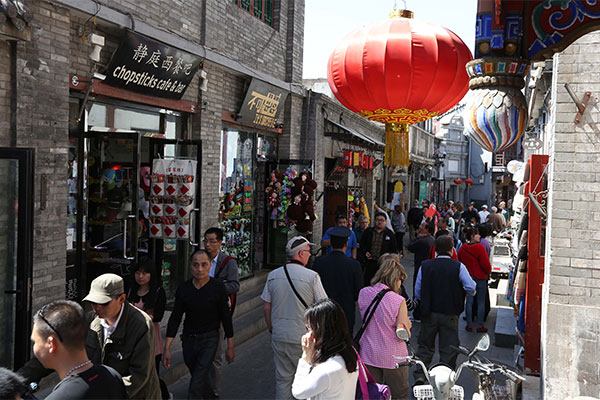
One last piece of advice
Did I say you don’t need to worry about getting lost in Beijing? Even if you have no sense of direction and don’t speak the language, it’s pretty hard to get lost as long as you know a few landmarks. You’ll walk away with much more than touristy snapshots. You’ll have a feeling that some of Beijing’s immense charm has rubbed off on you.
